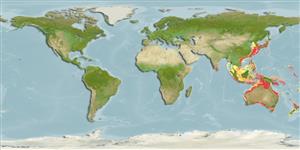Environment: milieu / climate zone / depth range / distribution range
Ecologia
marinhas; estuarina demersal; intervalo de profundidade ? - 150 m (Ref. 9563). Subtropical
Indo-West Pacific: most coasts of Australia.
Tamanho / Peso / Idade
Maturity: Lm ? range ? - ? cm
Max length : 34.0 cm TL macho/indeterminado; (Ref. 3132); common length : 22.5 cm SL macho/indeterminado; (Ref. 9774); peso máx. publicado: 1.5 kg (Ref. 3132)
Espinhos dorsais (total): 0; Raios dorsais (total): 65-74; Espinhos anais 0; Raios anais : 51 - 60. Body brownish, 2 conspicuous ocelli above and below lateral line and 1 or 2 ocelli on posterior part of straight section of lateral line, a dark blotch at junction of straight and curved portions of lateral line. Upper profile of head distinctly notched in front of upper eye. A line connecting base of first dorsal-fin ray and posterior nostril on eyed side crosses maxilla. Origin of dorsal fin slightly before anterior margin of upper eye and just above or behind posterior nostril on blind side. Pectoral fin on ocular side with 11-12 soft rays (Ref 9774).
Occurs in estuaries and offshore over sand or mud bottoms (Ref. 9563). Feeds on various benthic animals (Ref. 9774). Marketed fresh (Ref. 9774) and is considered an excellent food fish.
Ciclo de vida ou comportamento de acasalamento
Maturidade | Reprodução | Desova | Ovos | Fecundidade | Larvas
Distinct pairing (Ref. 205).
Robins, C.R., R.M. Bailey, C.E. Bond, J.R. Brooker, E.A. Lachner, R.N. Lea and W.B. Scott, 1991. World fishes important to North Americans. Exclusive of species from the continental waters of the United States and Canada. Am. Fish. Soc. Spec. Publ. (21):243 p. (Ref. 4537)
Status na Lista Vermelha da UICN (Ref. 130435)
Ameaça para os humanos
Harmless
Uso pelos humanos
Pescarias: espécies comerciais
Mais informação
ReferênciasAquaculturaPerfil para aquaculturaEstirpesGenéticaElectrophoresesHereditariedadeDoençasProcessamentoNutrientsConversão de massa
Ferramentas
Relatórios especiais
Baixar XML
Fontes da internet
Estimates based on models
Preferred temperature (Ref.
123201): 15.2 - 28.7, mean 25 °C (based on 964 cells).
Índice de diversidade filogenética (Ref.
82804): PD
50 = 0.5000 [Uniqueness, from 0.5 = low to 2.0 = high].
Bayesian length-weight: a=0.00741 (0.00343 - 0.01604), b=3.17 (3.00 - 3.34), in cm total length, based on LWR estimates for this Genus-body shape (Ref.
93245).
Nível Trófico (Ref.
69278): 3.5 ±0.37 se; based on food items.
Resiliência (Ref.
120179): Elevada, tempo mínimo de duplicação da população menor que 15 meses (Preliminary K or Fecundity.).
Fishing Vulnerability (Ref.
59153): Low vulnerability (24 of 100).
Nutrients (Ref.
124155): Calcium = 96.9 [45.9, 222.1] mg/100g; Iron = 1 [1, 2] mg/100g; Protein = 17.6 [15.6, 19.6] %; Omega3 = 0.235 [0.125, 0.434] g/100g; Selenium = 29.5 [14.7, 60.8] μg/100g; VitaminA = 7.58 [2.15, 27.85] μg/100g; Zinc = 0.75 [0.51, 1.09] mg/100g (wet weight);
